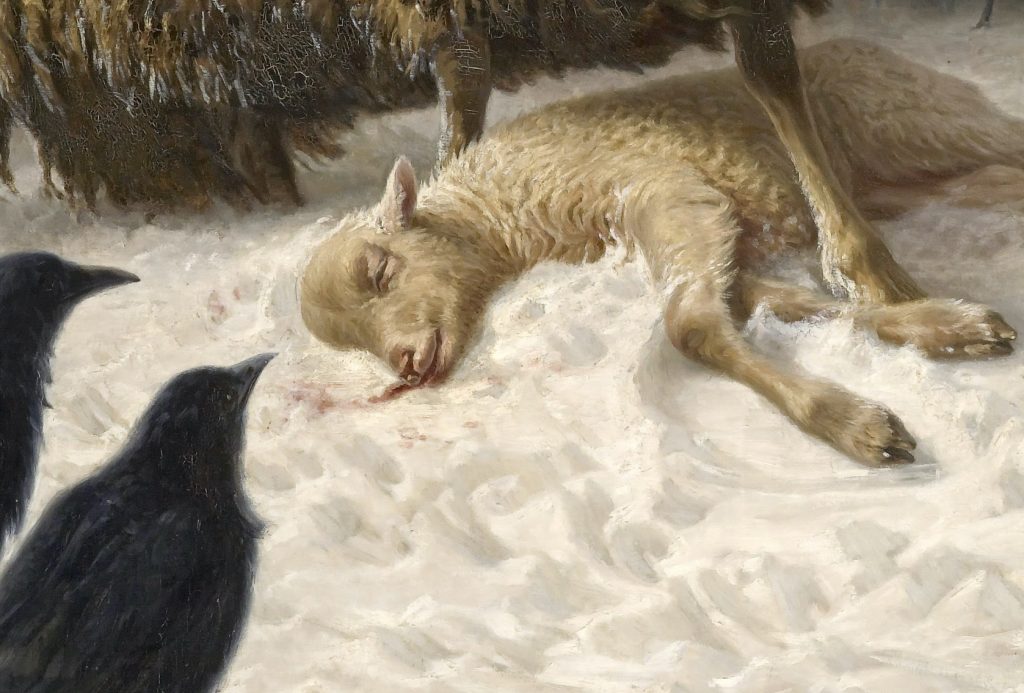Masterpiece Story: Allegorical Painting of Two Ladies
Allegorical Painting of Two Ladies is an enigmatic and highly unusual imaginative portrait made in 1650s England. It reveals a fascinating story...
Nicole Ganbold 14 October 2024
18 September 2024 min Read
Surrounded by menacing crows, a mother sheep wails in anguish as her lifeless young lamb rests on a snowy bed. This scene, painted by August Friedrich Albrecht Schenck around 1878, powerfully illustrates the capacity of art to evoke profound emotions.

August Friedrich Schenck, Anguish, c. 1878, National Gallery of Victoria, Melbourne, Australia.
In Anguish, a brave ewe stands defiantly over the limp body of her lamb. Blood from the lamb’s mouth trickles down, coloring the freezing snow. Once our gaze is caught by this touch of red, it suddenly tarnishes the luminosity provided by the faces of the two animals and the whiteness of the snow. The pair is surrounded by a mass of threatening black crows. In the distance, additional crows soar through the ominous brown sky, arriving to witness the scene. By showing this principle of accumulation of the same crow motif, the artist conveys the feeling of a hopeless situation, despite the bravery of the ewe. The painting was presented at the Salon of 1878 where it aroused strong emotions in visitors. Reproduced many times, it has been kept in the collections of the National Museum of Victoria in Melbourne, Australia since 1880.

August Friedrich Schenck, Anguish, c. 1878, National Gallery of Victoria, Melbourne, Australia. Detail.
Its composition and dull tones has been carefully considered to create a special atmosphere, drawing the viewer into a certain mood. The placement of the crows encircling the ewe and her lamb contributes to their threatening, almost suffocating role. The void between the crows in the foreground engages the viewer in this sad scene, making him almost an accomplice in the despair of the mother. The latter, her mouth open in a howl of pain – and her breath ghostly with cold – looks desperately into the distance, at the horizon, like a pieta imploring the sky for divine help.

August Friedrich Schenck, Anguish, c. 1878, National Gallery of Victoria, Melbourne, Australia. Detail.
Very little is known about the artist of this masterpiece. Born in 1828 in Glückstadt, Denmark (modern day Germany) August Friedrich Albrecht Schenck settled in Paris to study at the renowned École des Beaux-Arts. He spent most of his career there, specializing in painting landscapes and animals in distress, especially sheep, which were interpreted as a metaphor for human relationships. Thus, the staging of sheep, for example struggling with the elements, is a recurring motif for the artist. Thanks to his skills he was was even made a Chevalier of the Legion of Honor.
One of his other paintings represents an inverted version of Anguish. In L’Orphelin, souvenir d’Auvergne, presented at the 1885 Salon and kept at the Musée d’Orsay, a frail lamb presses against the body of its mother, under the watchful eyes of a cohort of crows.

August Friedrich Schenck, The Orphan. A Memory of Auvergne, c. 1885, Musée d’Orsay, Paris, France.
As we said earlier, Schenck’s animal subjects were seen as a metaphor for society and were very successful. Indeed, during the late 19th century, death was very fashionable partly because of Queen Victoria’s mourning her late husband, Prince Albert. At this time, suffering was everywhere in the society.
Dr. Ted Gott, National Gallery of Victoria Senior Curator in International Art, pointed out a possible influence Charles Darwin’s revolutionary theories on this painting. Indeed, the “father of evolution”, published On the Origin of Species in 1859, followed by The Expression of the Emotions in Man and Animals in 1872.
That’s the first study really that makes people realize that animals do suffer pain, loss and joy (…). That was a real turning point in scientific understanding, that the animal world is not just there for our consumption and pleasure.

August Friedrich Schenck, Anguish, c. 1878, National Gallery of Victoria, Melbourne, Australia. Detail.
Anguish was one of the National Gallery of Victoria’s earliest acquisitions. In 1906, the painting was voted among the five most popular in the collection – a success that was repeated over 100 years later in 2011. It only proves that its popularity continues. Today, Anguish still arouses emotions and will certainly continue to attract the attention of visitors for quite some time.

View of the Salon Gallery at National Gallery of Victoria, Melbourne, Australia. Photograph by Eugene Hyland. Source: TimeOut.
DailyArt Magazine needs your support. Every contribution, however big or small, is very valuable for our future. Thanks to it, we will be able to sustain and grow the Magazine. Thank you for your help!